UC Business & UC Team Smartphone user guide
Overview
Office UC provides Users with an application and series of features to enable Unified Communications across one or many devices. The Smartphone application will work across Apple iOS smartphones as well as Smartphones operating Android iOS.
The application comes with a standard branding.
This application is available on the following WHC technologies:
Centrex Users
- Foundation – as an add-on
- Functional – as an add-on
- Fixed – as an add-on
- Mobile - inclusive
SIPT Users
- Mobile - inclusive
Application Description-Office UC Smartphone
This application, available on the Mobile User license provides Users with the following:
Smartphone softphone application enabling:
- Voice and Video Calling – using inbuilt softphone or native dialler
- Call Centre Agent Login – when agent is assigned to an ACD
- Voice Recording Controls – where assigned and enabled
If a User is provided UC Business then the following additional functionality is provided:
- Desktop softphone application enabling, Voice and Video Calling – using inbuilt softphone or via hard- phone
- Instant Messaging and Presence (IM&P) from the provided applications
- Microsoft Skype for Business Plug-In
If a User is provided UC Team then the following additional functionality is provided:
- Personal Audio Conferencing for up to 8 people
- Desktop Sharing
Hardware & Software Description
In order to successfully install and use this application, the following installation and licensing requirements should be met:
These applications are running on the following firmware versions. If you are running on a later version we recommend you update to the latest.
|
Device |
Version |
|
Smartphone - iPhone |
22.6.7 |
|
Smartphone - Android |
22.6.7 |
The application supports devices with iOS 10 or later.
This application should run on iPhone 4S and later using the above operating systems. However, due to network, country and manufacturer variations, we are unable to maintain a full list of validated devices. However we can confirm that the application has been validated on the following reference devices:
- iPhone 5S – iOS 8.4.1
- iPhone 6 – iOS 9.3.5
- iPhone 6 plus – iOS 10.0.1
- iPhone 6S – iOS 10.0.1
- iPhone 6S Plus – iOS 9.3.5
- iPhone 7 – iOS 11.4
The application supports devices with Android 4.4 or later that conform to the hardware requirements set out below.
This application should run on any Android device using the above operating systems. However, due to network, country and manufacturer variations, we are unable to maintain a full list of validated devices. However we can confirm that the application has been validated on the following reference devices:
- Samsung Galaxy S4 (GT-I9505) – OS 4.4.2
- HTC One M8 – OS 4.4.4
- Motorola Moto G (XT1032) – OS 5
- Nexus 5X (LG) – OS 6
- Samsung Galaxy S7(G930F) – OS 6
- Samsung Galaxy S8 (G950F) – OS 8.0.0
- HTC 10 – OS 6
The following requirements need to be met:
- Dual-core CPU (or higher)
- 1 GB RAM (or higher)
- ARMv7 instruction set
- Minimum screen resolution 320 x 480
We strongly recommend that you use a known, stable, secure and correctly configured Wireless LAN and use the application over this Wi-Fi connection. If you are unsure please contact your system administrator for advice and assistance.
The application allows you to choose between a native call and a VoIP Call, there is also an Always Ask option available. The phone dialling service is recommended for use over a 3G connection. If you choose the ‘VoIP Call’ setting, then when a Wi-Fi connection is not available, the app will attempt to use the cellular data channel. Service and Voice quality may be impacted and data charges with your mobile carrier will apply.
Network and Firewall Requirements
You may need to allow outbound access for the following on your firewall:
|
Application |
Protocol |
Destination |
Destination Port |
|
Application Signaling |
SIP |
uc-bslnws09.yourwhc.co.uk 62.7.201.172 62.7.201.140
bs11lnws13.yourwhc.co.uk 213.120.60.140 213.120.60.204
ipcomms-uc-route62-bs11lnws13.yourwhc.co.uk 62.7.201.177 62.7.201.145
uc-bs12lnws14.yourwhc.co.uk 213.120.60.236 213.120.60.172
ipcomms-uc-route62-bs12lnws14.yourwhc.co.uk 62.7.201.182 62.7.201.150 |
UDP/TCP 5060, 5074, 5075, 8933 |
|
Application Media |
RTP |
62.7.201.132/32 62.7.201.141/32 62.7.201.146/32 62.7.201.164/32 62.7.201.173/32 62.7.201.178/32 213.120.60.132/32 213.120.60.164/32 213.120.60.196/32 213.120.60.228/32 |
UDP 32767 to 65535 |
|
Office UC Smartphone and Tablet Downloads |
n/a |
Apple Store Google Play Store
|
n/a |
|
Office UC Operation |
XSI
|
193.113.10.11 193.113.11.11 |
TCP 443
|
|
Office UC Presence |
XMPP
|
ums01.yourwhc.co.uk ums02.yourwhc.co.uk 193.113.10.7 193.113.11.7 |
TCP 5222 TCP 1081 TCP 5281 TCP 5269 TCP 443 |
|
Office UC Screenshare |
Proprietary |
uss01.yourwhc.co.uk uss02.yourwhc.co.uk 193.113.10.8 193.113.11.8 |
TCP 8443 |
Automatic Call Handover between Networks
We do NOT support automatic handover between Wi-Fi and 3G/4G networks for Calls that could be using Data Networks, and vice versa.
The feature that enables this has been switched off within the Core System, due in the main to the time it may take to re-establish a connection (up to 90 seconds) should the device want to switch because of a movement into or out of a particular network type. However there are other scenarios where problems have been seen.
- On Android 6.0, a 3G to Wi-Fi call handover fails no matter of the keep config value because a network lock cannot be acquired (OS limitation).
- Picking up a Wi-Fi that required username/password to be entered via a website (think hotels)
- SIP ALG on random networks
The current behavior is this:
If an Office UC VoIP call is begun on 4G (i.e. the phone is not in Wi-Fi range) and the phone moves into range and picks up a Wi-Fi connection
- The call WILL NOT transit to Wi-Fi
- It will remain on 4G until the call is terminated normally
- The next call will be made/received over the Wi-Fi connection
Conversely if an Office UC VoIP call is begun on a Wi-Fi connection and the phone moves out of Wi-Fi range
- The call WILL NOT transit to 3/4G
- The call will drop
- The next call will be made/received over the 3/4G connection
For a) Wi-Fi to Wi-Fi, I.e. movement within a larger network, which may involve changing the access point or use of a Wi-Fi extender that the User is connected to and, b) Wi-Fi to Wi-Fi that is not part of the same network infrastructure with different access circuits, both may work but are NOT supported.
Both scenarios are possible, but from testing, we cannot guarantee that the function will work every time or even at all, due to a number of factors:
- The type and configuration of the equipment being used for providing the Wi-Fi network service (there are too many equipment scenarios to choose from and we cannot test them all)
- The signal Strengths offered by the Access Points during the handover phase
- The location where the handover is being performed may have other factors that interfere with the re-establishment whilst the person is moving, e.g. blind spots, Radio Interference, Device OS etc.
- The time taken to re-establish the connection between Wi-Fi access points could be excessive, and may never re-establish.
Provisioning & Configuration
Once this license pack has been ordered from the IC, the application download will appear in the Application section of the Business Portal as per the image below.
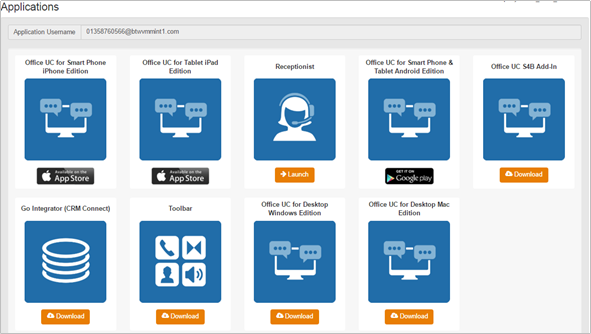
Download & Installation Instructions
Once you have the correct license and the User has received, or is in possession of their welcome email, they can now download the application from the Apple App Store or Google Play Store.
Please ensure you download the version called ‘Office UC’ from BT and NOT the version called ‘UC Office.’ The latter is the version used on WHC 1.0 and not WHC 2.0.
Apple Store Google Store


The Welcome Email sent to you will guide you to navigate to the Business Portal to obtain your Password. Please note this Username is the same for all Applications, but is different to the Business Portal credentials. The username can be seen in the Applications tab as shown below and is sent in the Welcome email

The password for all applications is not sent to the User and needs to be set in the Business Portal by navigating to My Account,

Select Password to Change box, then click on Application, enter password and then select Save.

Operating the Feature –iPhone
Tap the application icon on the device to launch the application.

On first time login you will be asked to agree to the applications terms, please review and then select Accept to proceed.

Tap the application icon on the device to launch the application.

On first time login you will be asked to agree to the applications terms, please review and then select Accept to proceed

Once you have accepted the license terms, the application presents you with the login screen where you need to provide your user account information. Enter your username and password into the appropriate boxes. Select whether you would like the app to remember your password, and also if you want it to sign you in automatically on subsequent launches. Click Sign-in.

Username and Password Management
You must login to the application with your Application Username and Password, which can be obtained from the Business Portal. The password can also be modified via the Business Portal.
To quit select Settings followed by Sign out or double-tap the home button on the device to close the application.
When you start the application for the first time, you will presented with a series of requests asking you the following:
- “Office UC” Would Like to Access Your Contacts – select OK if you want your local phone contacts to be available in the application.

- “Office UC” Would Like to Access The Microphone – you must select OK in order for the application to work as a softphone.
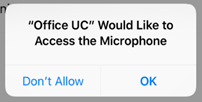
- “Office UC” Would Like to Access The Camera – select OK if you want your phone to be able access your Photo Stream, used to upload pictures against your profile
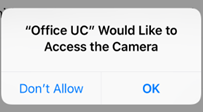
Within this start-up window view there are a number of tabs, located on the left-hand bar, each of which will be explained as you navigate your way through this guide.
- Contacts
- Chat
- Call
- History
- My Room
When you land on this page for the first time, it is empty and needs populating with some contacts, using one of the methods described further on. For information, once you start populating these, you can add them as either of the following:
- Favorites – Regular people you want to communicate with whom are also using the service.
- All Contacts – Other people you want to communicate with including local phone contacts
Add Contact from iPhone Contacts or WHC Directory
To add contacts from your iPhone, selected the orange arrow from the Office UC option at to the top of the page.

Select iPhone Contacts to bring up a list of all of your contacts, and then click on one of the entries.


To add to your contacts simply select the button next to the Add Contacts parameter, followed on the Yes button to add this to your contacts page.

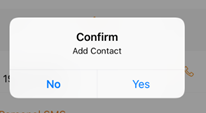
To add from contacts built on WHC, change the setting to Directory, and then type in the name to search for the user.

Using the same method above, you can either add them as a Contact or a Favorite.
After you have done this, you can change the setting back to just show you’re Office UC Contacts and you have the choice of displaying:
- All – all contacts online and off-line
- Online – contacts online

Monitors a User’s Presence Status
To monitor a user’s presence status you need to request this and they need to accept. Tap a contact from the Contacts list to open a contact card, followed by the edit button, then select Subscribe.

A user’s presence can only been seen if they also have the Office UC App and their IM address is populated in the profile card
Contacts can also be added manually by tapping the button from the top right-hand corner.

Followed by either:
- Add Contact – will allow you to add a regular contact.
- Add Conference – will allow you to add a Conference number along with a security pin, making dialling into a conference bridge simple.
- Add iPhone Contact – will allow you to add a Contact to your iPhone device

In the Add Contact screen, enter the contact’s information and then select Done. By default, your presence information is always shared with a new contact if an XMPP address is provided.
If you receive a presence request, you can Decline or Accept it.

If you decline the request, you can always share your presence information later by selecting Subscribe from the contact card. Note that the contact must accept your subscription request for you to establish the presence relationship successfully.
Tap a contact from the Contacts list to open a contact card. This is the same for presence-enable and non-presence-enabled contacts.
- The Edit button opens the Contact Information dialog box where you can add, edit or remove information. This works for both presence-enabled and non-presence-enabled contacts.
- Select Unsubscribe to remove the presence relationship between you and that contact. This means you do not see the contact’s presence information and your contact does not see yours.
- Select Subscribe to re-establish a presence relationship. An unsubscribed contact remains on the Contacts list and is always shown as “offline”.
- Select Remove to remove the contact from your Contacts list.
Presence (UC Business & Team only)
For each contact to which you have subscribed, you can see their presence. Similarly, your contacts can see your presence on their Contacts list. Presence means that your friends are able to see whether you are available, for example, “I’m available” or “I’m busy”.
The list of presence flags are as follows:
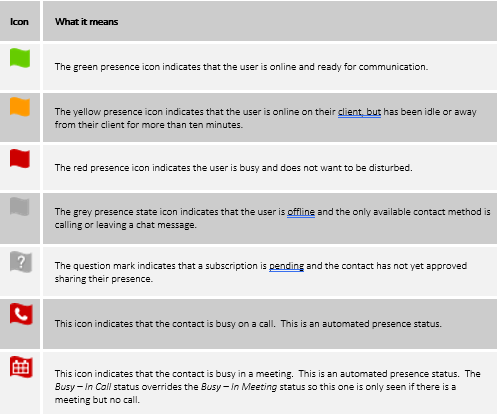
You can manually set your own presence by tapping on the Presence icon from the status bar, top left hand side.

Followed by pressing anywhere in the blue/grey screen.

This will open the My Status screen where you can change your avatar, personal message, and presence status.

Your avatar is the picture that represents you in your friends’ Contacts list and in chat screens. Tapping on an avatar opens a dialog with options to select an existing image,
to take a new one with your phone camera, or to clear your avatar. You can enter a status message in the area next to the avatar. This status text is shown in your friends’ Contacts list.
If you see the error message, “Chat Unavailable”, under any tab, it means that the XMPP connectivity has been lost for chat and presence; however, you can still make calls. In this case, you should contact your service provider. The presence update is only triggered by appointments and meetings that are either accepted by the user or made by them. Note that all-day meetings do not trigger a presence change to Busy – In Meeting.
For contacts that have a listed email address or mobile phone number, you are able to click the email icon (envelope), or SMS icon next to the users address/phone number. This will then use the clients default email application and open up a new message/phone, with the contacts email address/SMS number already inserted into the ‘To’ address.
Chat (UC Business & Team only)
The Chat tab shows the list of recent chats since the last login. Chats are listed so that the newest one is always at the top. Chats are not in alphabetical order and are always listed with the most recent first. If User A chats with User B multiple times, their discussions appear as one item in the list. New incoming messages are indicated with a notification badge to the right of the name. The icon remains next to the name until the message is read.

- You can chat with a contact by using any of the methods below:
- Tap a contact from the Contacts list to open a contact card. From the contact card, choose the chat icon to start a chat.
- In the Chat History list, tap a contact entry to start a chat.
- From Contact search results, tap a contact to open the contact card and then choose the chat icon.
When you initiate a chat, the Chat screen opens. Chatting with a contact is possible only when you are both online. If your contact initiates a chat, you see a notification badge on the Chat tab and the entry appears at the top of the Chat History list. Once a chat opens, the name of the recipient is on the top bar and there is a presence icon flag before the name. The recipient’s messages are presented in the light orange background and the user is presented in the light grey background.

- During a chat the orange bar at the top provides the following different options:
- Left arrow – return to the main chat window
- Phone Handset – select this to phone the person
- Video Camera – select this to video call the person, if available
- Group Chat– select this to add users to the chat
- Dots – select this to view the profile of the person or clear the chat history

Start a group chat using one of the following methods:
- In single chat session, tap the add participant icon to escalate from a single to a group chat.
- From the History Chat tab, tap on the 3 dots icon to select the “start group chat” option.
- In the Chat History list, tap a group communication entry to start a group chat.

When you initiate a group chat, the Chat screen opens. More participants can be added later to the chat using the add participant icon. Anyone in the group chat can add participants. However, removing participants is currently not supported.
A group chat works the same way as a one-on-one chat. All messages from any participant are sent to everyone else. All contacts need to be online to be able to participate in a group chat. You cannot invite an offline contact. A group chat history is saved and is available to view later from the Chat tab.
A user can leave a group chat by selecting the 3 dots button followed by the Leave chat option. The chat is marked as “offline” and the user no longer receives messages from the chat. When tapping on the “offline” chat, the user re-joins the room and starts receiving messages. However, the user does not receive the messages that were sent in the chat while the user was outside of the room.
The Clear History menu item behaves the same way as the corresponding option in the one-on-one chat and removes the local history. The View Participants button opens a dialog that shows the list of participants in the group chat. Note that deleting a chat room is not supported.
The Call tab displays a dial pad to enter numbers. The dial pad is one of the options used to make audio or video calls. There are three buttons below the dial pad:
- Video Call (video icon) – enter the number and select this to make a video call.
- Audio Call (handset icon) – enter the number and select this to make a voice call.
- Pull Call (3 dots icon) – select this to pull a call from your desk IP phone onto the application, useful if you need to leave the office.

A badge notification appears on the Call tab when there are messages in the voicemail box.

The voicemail icon underneath the number 1 key also goes orange. A long press on the “1” digit connects you to the voicemail box.

You can make an audio or video call using one of the following methods:
- Tap a contact from the Contacts list to open a contact card. From the contact card, choose the headset icon to make an audio call or the video icon to make a video call.
- From search results, open a contact card and tap on the headset icon for an audio call or the video icon to perform a video call.
- Open the dial pad, enter a phone number, and tap the Call or Video button.
- On the Call History list, tap a call entry.
- On the Chat screen, tap the headset icon to make an audio call or the video icon to make a video call.
An incoming call is indicated with a ringtone. There are two options on the incoming call screen: Accept and Decline. If you decline the call, it causes the line to sound busy at the caller’s end and they know that you rejected the call.

From the main In Call screen, you can perform the following actions:
- Mute the microphone
- Place a call on hold
- Speakerphone
- Open the dial pad
- Change from audio to video call and change from video to audio call
- Start a New Call
- End a call

If you push the button with the three dots, then you get the following additional options:
- Transfer a call
- Conference
- Transfer a call to Mobile

The application can be run in the background, whilst the phone is locked and will still receive calls and notifications.
If you have the Voice Recording add-on and have set one of the settings below from the Business Portal, then you will be able to use the feature from the application:
- Always with Pause/Resume – records all calls and user can use pause/resume multiple times as per the image below:
- On Demand – calls are not recorded unless you select the Recording button from the application. Once you start recording it will record the entire call from start to finish, including the part of the call prior to the FAC being entered. Once recording has been activated, the option to pause/resume the call recording becomes available as well.
- On Demand with User Initiated Start – Calls are not recorded unless you select the ‘start recording’ from the application. Once you start recording, it will only begin recording the call from point at which the FAC was entered. Once started, the options to pause/resume call recording become available along with the option to stop recording the call altogether. Once stopped, call recording can be started again within the same continuous voice call but this new phase of recording would appear as a separate call in the recorded calls list and will not be appended to any earlier recordings
- Voice Recording controls are not available if any of the following settings are in use:

When you miss a call, the notification bar on the device shows a numerical note on the Call and History badge icon. It will also show on the devices notification pop-ups if enabled, clicking on the notification will take you to the Call history in the app.
Voicemail is also accessible with a long press of the dial pad “1” key (similar to how it is on a regular mobile dial pad). If voicemail messages are available, then the “1” key changes color. In addition, a voicemail notification is displayed as a badge on the Call tab icon.
Contact Name Lookup for Incoming Calls and Call Logs
Whenever an incoming call does not have a calling name associated with it, the device performs a local contact search. If the number matches one of the contacts on the devices Contacts list, the name is shown on the incoming Call screen along with the alert.
When a user retrieves their call logs/history and the call log does not have a calling name associated with it, the client does a lookup in the local contacts and populates the name if a match is found.
You can have one active call at any one time if you receive a new incoming call and accept it. The existing call is put on hold and you can change between these two calls by using the Hold and Unhold buttons.
The client supports starting a new call while in an ongoing call. The steps are as follows:
- Establish call with remote party.
- Initiate second call using the new call button.
- Select a contact then choose a number. After the new call is established, the first call is put on hold. The active call can be toggled by tapping on the call details in the display.
The client supports transferring VoIP calls to another party. Two modes of transfer are supported:
- Attended Transfer – Establish a call with remote party. Select a contact then choose a number. Select the call first option. If the call is successfully established, you can talk with the third party privately before completing the transfer by pressing the Complete button.
- Unattended Transfer – Establish a call with remote party. Select a contact then choose a number. Select the Transfer option and the transfer is completed.
The client supports transferring VoIP calls to another party. Two modes of transfer are supported:
- Attended Transfer – Establish a call with remote party. Select a contact then choose a number. Select the call first opti If the call is successfully established, you can talk with the third party privately before completing the transfer by pressing the Complete button.
- Unattended Transfer – Establish a call with remote party. Select a contact then choose a number. Select the Transfer option and the transfer is completed.Bluetooth Headset Support
The application supports the use of Bluetooth headset for incoming and outgoing calls. The following headsets have been tested, although other devices should also work:
- Plantronics Voyager Legend
- Plantronics m155
Note that the application supports switching the audio source within the application between the Bluetooth device and the phone microphone and speaker. However, answering a call, hang up, mute, and adjusting the volume from the Bluetooth device are not supported.
Call history can be accessed from the History tab. The application saves a call history for placed, received, and missed calls. Call history makes it easy for you to redial and call back when you miss a call or when you want to dial a contact with whom you have recently spoken with.
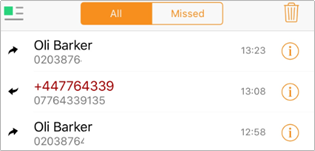
You can filter by All (all calls), or filter by Missed calls to make it clearer. Likewise you can choose to select the dustbin icon to delete all call history.

An incoming call is indicated by an arrow to the left, and if answered the number is grey/black. If unanswered the number will be red. An outgoing call is indicated an arrow to the right and if answered the number is grey/black.

Selecting the information icon also allows further controls such as video call.
My Room is an always available and a permanent room that you can use to chat with anyone that joins. My Room is accessible using the My Room icon in the Tab bar or by selecting My Room from the Conversations menu bar.
You can add more participants using the add participants icon or they can join your room from your contact card. Once participants join the chat room, they can tap on the Call button of that screen to automatically join the conference.
My Room uses your permanent chat room and a conference bridge (audio or video). All My Room sessions start as chats but a call can be added to the session while in progress. Others join your room by clicking your name on their Contacts list and selecting Join Room from the contact card.
My Room Audio Conferencing 8 provides Personal Audio Conferences for up to 8 attendees per conference. It is included in the chargeable UC Team Add-On that can be applied to Users. It is a personal, reservation less audio conferencing service that can be accessed from any phone.
My Room Audio Conferencing requires a My Room Bridge to be added at the Site level. If the bridge exists, a user conference is automatically created for the user with default settings. If the bridge does not yet exist, no conference will be created. The required My Room Conferencing 8 conference will then be automatically added when the Site’s My Room Bridge is created from the Business Portal.
The default settings for the conference can be changed from the user’s Business Portal under “My Room” in their Feature Settings. The user can also see their conference ID and PIN from this page. If the user conference does not exist (meaning the bridge does not exist), the user is informed to contact the system administrator.
For security reasons, only the user can reset the PINs associated to his conference. This is achieved by deleting and re-adding the conference (options are transferred to the new conference automatically).
Contacts outside of the Company can attend Audio Conferences by being sent the access details within an email invitation.
Screenshot of My Room Feature Settings page in the Business Portal:

For users that are assigned as an agent of a Call Centre and have the ACD option enabled for their Smart Phone device, the Call Centre login feature includes the following functionality:
- Viewing assigned Call Centres
- Joining \ Leaving Call Centres
- Setting Automatic Call Distribution (ACD) status for each assigned Call Centre
Selecting ‘Queues’ from the menu button opens the Queues dialog box:
This gives the ability to change the current ACD state by selecting from the drop-down list (Available, Wrap-up, etc.), and also to join or leave a particular Call Centre (configuration dependent).
The Side Navigation bar is accessed by swiping from left to right on the main screen, and it contains the following items:
- My Status (Top section in grey/blue)
- Call Settings
- Preferences
- Queues (see Call Centre Agent Login)
- About
- Help
- Sign out

You can set your own presence by tapping on your personal status from the side navigation. It opens the My status screen where you can change your avatar, personal message, and presence status.
Your avatar is the picture that represents you in your friends’ Contacts lists and in chat screens. Tapping on an avatar opens a dialog with options to select an existing image, to take a new one with your device’s camera, or to clear your avatar.
You can enter a status message into the area next to the avatar. This status text is shown in your friends’ Contacts lists.
If you see the error message “Chat Unavailable” under any tab, it means that XMPP connectivity has been lost for chat and presence; however, you can still make calls.
The client supports the following service management features, allowing supplementary services to be viewed or updated using the native client Preferences window:
Call Options
- Block My Caller ID
- Dialing Service
Call Forwarding
- No Answer
- Always
- Not Reachable
- Busy
Do Not Disturb
Incoming Calls
- Simulteneous Ring Personal
Office UC
- Call Director
- Remote Office
|
Option |
Description |
|
Call Options |
Block My caller ID - You can hide or display your number when calling or communicating with other parties or contacts. To hide your number, set to “Enable”. To show your number, set to “Disable”. Dialing Service - Choose between:
|
|
Call Forwarding |
By tapping on a different Call Forward option, you can enter a number to forward your calls to in the event of any of the following:
|
|
Do Not Disturb |
When you activate this service, all calls are blocked and sent to voicemail, where voicemail is available. |
|
Incoming Calls |
Simultaneous Ring Personal - This feature allows you to set up to ten phone numbers that would ring in addition to the primary phone number when you receive a call. |
|
Office UC |
Remote Office - This service allows the use of any phone as the office phone from a charging and numbering perspective. For instance, a hotel room phone can be used as the office phone. Enable Remote Office and specify a phone number to be used as the Remote Office number. Call Director - This service allows users to enable their mobile phones to behave as if the phones were an extension of their telephone number. Locations, numbers assigned to a mobile, can be added and the activated/deactivated at any time. Likewise when click-to-dial is enabled, the user can choose to notify all devices or just the primary device. Click on the Add Location button, enter the number of the phone that you wish to use, along with a brief description, followed by Active. The following options are then available:
|
The client supports the following preferences:
- Language
- Remember Password
- Troubleshooting
- Caller ID lookup
Language
You can change the language of the application from this option.
Remember Password
Allow the application to remember the password to make signing in easier.
Troubleshooting
The application requires a User to enter the correct Username and Password and have the correct features assigned. If the Username and/or Password are incorrect or the User does not have the required features then an appropriate error message will be displayed at the login process. If you are sure that the provisioning, login and licensing is correct then please check network connectivity, and the Requirements section of this document including Network and Firewall Requirements.
If problems still persist, logging can be enabled via the “Troubleshooting” menu within “Settings”. Once enabled, the application will collect information which can be emailed to your support engineers for further diagnostics. Troubleshooting is managed by a menu entry in Settings. It can be accessed from the following place:
- From the Settings/Preferences button – This opens the screen that contains the help and troubleshooting-related entries. This can also be used before the user has signed in.
Caller ID lookup
Whenever an incoming call does not have a calling name associated with it, the device performs a local contact search. If the number matches one of the contacts on the phone’s Contacts list, the name is shown on the incoming Call screen along with the alert.
Office UC provides support for users with multiple devices. This includes several features:
- Chat invitations are sent to all devices. Before the session is accepted, messages are sent to all devices, and once answered, the chat messages go to the device that has sent a reply message.
- Retrieving one’s own presence notifications, when another client updates the user’s presence. The client updates its own status based on the information it receives from the server.
- Accepting a shared presence invitation in one client is also recognized by another client, and both clients start receiving presence updates.
- A new presence subscription made in one client is recognized in another. If the contact blocks the invitation, there are presence notifications from the server to all of the user’s clients indicating that the subscription was terminated, and this information is shown to the user. If the client receives two presence authorisation requests from two or more devices for the same user, it only shows one request to the user.
- Removing a contact from a Contacts list in one device is recognized in another client, and the Contacts list is updated (that is, the contact is removed) in the other client as well.
Operating the Feature –Android
Tap the application icon on the device to launch the application.

On first time login you will be asked to agree to the applications terms, please review and then select Accept to proceed.

Once the application launches for the first time, you will be presented with the following:
- “Office UC” Permissions Required select OK for the application to be given access to Camera, Microphone, Contacts and Calls

Once you have accepted the license terms, the application presents you with the login screen where you need to provide your user account information. Enter your username and password into the appropriate boxes. Select whether you would like the app to remember your password, and also if you want it to sign you in automatically on subsequent launches. Click Sign-in.

Username and Password Management
You must login to the application with your Application Username and Password, which can be obtained from the Business Portal. The password can also be modified via the Business Portal.
To quit select Settings followed by Sign out or double-tap the home button on the device to close the application.
When you start the application for the first time, you will presented with a series of requests asking you the following:
“Office UC” Would Like to Access Your Contacts – select Allow if you want your local phone contacts to be available in the application.

- “Office UC” Would Like to to take pictures and record video – you must select Allow in order for the application to work as a softphone.
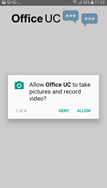
- Office UC” to make and manage phone calls select Allow

Within this start-up window view there are a number of tabs, located on the left-hand bar, each of which will be explained as you navigate your way through this guide.
- Contacts
- Chat
- Call
- History
- My Room
When you land on this page for the first time, it is empty and needs populating with some contacts, using one of the methods described further on. For information, once you start populating these, you can add them as either of the following:
- Favourites – Regular people you want to communicate with whom are also using the service.
- All Contacts- - Other people you want to communicate with including local phone contacts
Add Contact from Phone Contacts or WHC Directory
To add contacts from your Mobile Phone, selected the orange arrow from the Office UC option at to the top of the page.

Select Contacts to bring up a list of all of your contacts, and then click on one of the entries.


To add to your contacts simply select the button next to the Add to Contacts parameter, followed on the OK button to add this to your contacts page. You can add additional information for this contact if you have it to hand before using the OK option
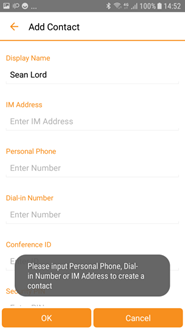
To add from contacts built on WHC, change the setting to Directory, and then type in the name to search for the user.
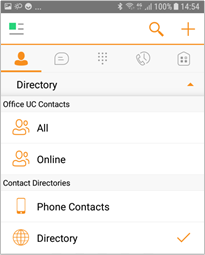
Using the same method above, you can either add them as a Contact or a Favorite.
After you have done this, you can change the setting back to just show your Office UC Contacts and you have the choice of displaying:
- All – all contacts online and off-line
- Online – contacts online
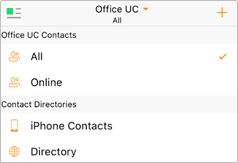
Monitor a User’s Presence Status
To monitor a user’s presence status you need to request this and they need to accept. Tap a contact from the Contacts list to open a contact card, select the 3 dots on top right hand corner followed by the edit button, then select Subscribe.



Within Contacts, selecting the icon at the top right of the screen, reveals a dropdown menu asking what type of entry you would like to add your contact as. Select Add Contact. A new screen will appear, allowing you enter the contact manually. Press OK when you are satisfied that the contact information is correct. Note: to Enable Chat and presence information, the IM address will need to be in the format: contact.name@ums.yourwhc.co.uk Ask your contact what their IM address is to ensure it is entered correctly.
Contacts can also be added manually by tapping the button from the top right-hand corner.


Followed by either:
- Add Contact – will allow you to add a regular contact.
- Add Conference – will allow you to add a Conference number along with a security pin, making dialing into a conference bridge simple.
- Add Phone Contact – will allow you to add a contact to your device’s directory
In the Add Contact screen, enter the contact’s information and then select Done. By default, your presence information is always shared with a new contact if an XMPP address is provided.
If you receive a presence request, you can decline or accept it.

If you decline the request, you can always share your presence information later by selecting Subscribe from the contact card. Note that the contact must accept your subscription request for you to establish the presence relationship successfully.
Tap a contact from the Contacts list to open a contact card. This is the same for presence-enable and non-presence-enabled contacts.
- The Edit button opens the Contact Information dialog box where you can add, edit or remove information. This works for both presence-enabled and non-presence-enabled contacts.
- Select Unsubscribe to remove the presence relationship between you and that contact. This means you do not see the contact’s presence information and your contact does not see yours.
- Select Subscribe to re-establish a presence relationship. An unsubscribed contact remains on the Contacts list and is always shown as “offline”.
- Select Remove to remove the contact from your Contacts list.
Presence (UC Business & Team only)
For each contact to which you have subscribed, you can see their presence. Similarly, your contacts can see your presence on their Contacts list. Presence means that your friends are able to see whether you are available, for example, “I’m available” or “I’m busy”. You can manually set your own presence by tapping on the Presence icon from the status bar, top left hand side.

The list of presence flags are as follows:

Followed by pressing anywhere in the blue/grey screen.

This will open the My Status screen where you can change your avatar, personal message, and presence status.

Your avatar is the picture that represents you in your friends’ Contacts list and in chat screens. Tapping on an avatar opens a dialog with options to select an existing image,
to take a new one with your phone camera, or to clear your avatar. You can enter a status message in the area next to the avatar. This status text is shown in your friends’ Contacts list.
If you see the error message, “Chat Unavailable”, under any tab, it means that the XMPP connectivity has been lost for chat and presence; however, you can still make calls. In this case, you should contact your service provider. The presence update is only triggered by appointments and meetings that are either accepted by the user or made by them. Note that all-day meetings do not trigger a presence change to Busy – In Meeting
For contacts that have a listed email address or mobile phone number, you are able to click the email icon (envelope), or SMS icon next to the users address/phone number. This will then use the clients default email application and open up a new message/phone, with the contacts email address/SMS number already inserted into the ‘To’ address.
Chat (UC Business & Team only)
The Chat tab shows the list of recent chats since the last login. Chats are listed so that the newest one is always at the top. Chats are not in alphabetical order and are always listed with the most recent first. If User A chats with User B multiple times, their discussions appear as one item in the list. New incoming messages are indicated with a notification badge to the right of the name. The icon remains next to the name until the message is read.

You can chat with a contact by using any of the methods below:
- Tap a contact from the Contacts list to open a contact card. From the contact card, choose the chat icon to start a chat.
- In the Chat History list, tap a contact entry to start a chat.
- From Contact search results, tap a contact to open the contact card and then choose the chat icon.
When you initiate a chat, the Chat screen opens. Chatting with a contact is possible only when you are both online. If your contact initiates a chat, you see a notification badge on the Chat tab and the entry appears at the top of the Chat History list. Once a chat opens, the name of the recipient is on the top bar and there is a presence icon flag before the name. The recipient’s messages are presented in the orange background and the user is presented in the grey background.

During a chat the orange bar at the top provides the following different options:
- Left arrow – return to the main chat window
- Phone Handset – select this to phone the person
- Video Camera – select this to video call the person, if available
- Group Chat– select this to add users to the chat
- Dots – select this to view the profile

Start a group chat using one of the following methods:
- In single chat session, tap the add participant icon to escalate from a single to a group chat.
- From the Chat tab, tap on the 3 dots icon to select the “start group chat” option.
- In the Chat History list, tap a group communication entry to start a group chat

When you initiate a group chat, the Chat screen opens. More participants can be added later to the chat using the add participant icon. Anyone in the group chat can add participants. However, removing participants is currently not supported.
A group chat works the same way as a one-on-one chat. All messages from anyone are sent to everyone else. All contacts need to be online to be able to participate in a group chat. You cannot invite an offline contact. A group chat history is saved and is available to view later from the Chat tab.
A user can leave a group chat by selecting the 3 dots button followed by the Leave chat option. The chat is marked as “offline” and the user no longer receives messages from the chat. When tapping on the “offline” chat, the user re-joins the room and starts receiving messages. However, the user does not receive the messages that were sent in the chat while the user was outside of the room.
The Clear History menu item behaves the same way as the corresponding option in the one-on-one chat and removes the local history. The View Participants button opens a dialog that shows the list of participants in the group chat. Note that deleting a chat room is not supported.
The Call tab displays a dial pad to enter numbers. The dial pad is one of the options used to make audio or video calls. There are three buttons below the dial pad:
- Video Call (video icon) – enter the number and select this to make a video call.
- Audio Call (handset icon) – enter the number and select this to make a voice call.
- Pull Call (3 dots icon) – select this to pull a call from your IP phone onto the application, useful if you need to leave the office.

A badge notification appears on the Call tab when there are messages in the voicemail box.

The voicemail icon underneath the number 1 key also goes orange. A long press on the “1” digit connects you to the voicemail box.

You can make an audio or video call using one of the following methods:
- Tap a contact from the Contacts list to open a contact card. From the contact card, choose the headset icon to make an audio call or the video icon to make a video call.
- From search results, open a contact card and tap on the headset icon for an audio call or the video icon to perform a video call.
- Open the dial pad, enter a phone number, and tap the Call or Video button.
- On the Call History list, tap a call entry.
- On the Chat screen, tap the headset icon to make an audio call or the video icon to make a video call.

An incoming call is indicated with a ringtone. There are two options on the incoming call screen: Accept and Decline. If you decline the call, it causes the line to sound busy at the caller’s end and they know that you rejected the call.
From the main In Call screen, you can perform the following actions:
- Mute the microphone
- Place a call on hold
- Speakerphone
- Open the dial pad
- Escalate from audio to video call and downgrade from video to audio call
- Start a New Call
- End a call

If you push the button with the three dots, then you get the following additional options:
- Transfer a call
- Conference
- Transfer a call to Mobile

The application can be run in the background, whilst the phone is locked and will still receive calls and notifications.
If you have the Voice Recording add-on and have set one of the settings below from the Business Portal, then you will be able to use the feature from the application:
- Always with Pause/Resume – records all calls and user can use pause/resume multiple times as per the image below:
- On Demand – calls are not recorded unless you select the Recording button from the application. Once you start recording it will record the entire call from start to finish, including the part of the call prior to the FAC being entered. Once recording has been activated, the option to pause/resume the call recording becomes available as well.
- On Demand with User Initiated Start – Calls are not recorded unless you select the ‘start recording’ from the application. Once you start recording, it will only begin recording the call from point at which the FAC was entered. Once started, the options to pause/resume call recording become available along with the option to stop recording the call altogether. Once stopped, call recording can be started again within the same continuous voice call but this new phase of recording would appear as a separate call in the recorded calls list and will not be appended to any earlier recordings
Voice Recording controls are not available if any of the following settings are in use:
- Always
- Never
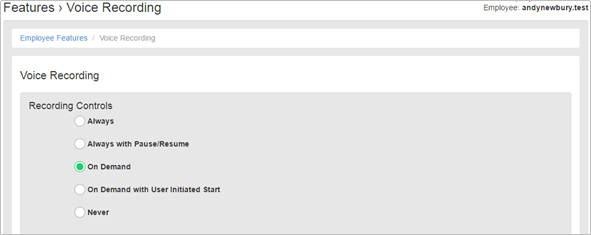
Missed Calls and new Messages
When you miss a call, the notification bar on the device shows a numerical note on the Call and History badge icon. It will also show on the devices notification pop-ups if enabled, clicking on the notification will take you to the Call history in the app.
Voicemail is also accessible with a long press of the dial pad “1” key (similar to how it is on a regular mobile dial pad). If voicemail messages are available, then the “1” key changes color. In addition, a voicemail notification is displayed as a badge on the Call tab icon.
Contact Name Lookup for Incoming Calls and Call Logs
Whenever an incoming call does not have a calling name associated with it, the device performs a local contact search. If the number matches one of the contacts on the devices Contacts list, the name is shown on the incoming Call screen along with the alert.
When a user retrieves their call logs/history and the call log does not have a calling name associated with it, the client does a lookup in the local contacts and populates the name if a match is found.
You can have one active call at any one time if you receive a new incoming call and accept it. The existing call is put on hold and you can change between these two calls by using the Hold and Unhold buttons.
The client supports starting a new call while in an ongoing call. The steps are as follows:
- Establish call with remote party.
- Initiate second call using the new call button.
- Select a contact then choose a number. After the new call is established, the first call is put on hold. The active call can be toggled by tapping on the call details in the display.
The client supports transferring VoIP calls to another party. Two modes of transfer are supported:
- Attended Transfer – Establish a call with remote party. Select a contact then choose a number. Select the call first option. If the call is successfully established, you can talk with the third party privately before completing the transfer by pressing the Complete button.
- Unattended Transfer – Establish a call with remote party. Select a contact then choose a number. Select the Transfer option and the transfer is completed.
Call Move can be used in scenarios where a user has Shared Call Appearance or Call Director. For instance, if the user has an active call on the desk phone, this can be transferred seamlessly to the smartphone via the Call Pull button. Depending on the application, dialing settings, and service configuration, the call can be pulled as a VoIP or circuit-switched call to the mobile phone. There is no interruption to the voice call.
The application supports the use of Bluetooth headset for incoming and outgoing calls. The following headsets have been tested, although other devices should also work:
- Plantronics Voyager Legend
- Plantronics m155
Note that the application supports switching the audio source within the application between the Bluetooth device and the phone microphone and speaker. However, answering a call, hang up, mute, and adjusting the volume from the Bluetooth device are not supported.
Call history can be accessed from the History tab. The application saves a call history for placed, received, and missed calls. Call history makes it easy for you to redial and call back when you miss a call or when you want to dial a contact with whom you have recently spoken with.

You can filter by All (all calls), or filter by Missed calls to make it clearer. Likewise you can choose to select the dustbin icon to delete all call history.

An incoming call is indicated by an arrow to the left, and if answered the number is grey/black. If unanswered the number will be red. An outgoing call is indicated an arrow to the right and if answered the number is grey/black.
Selecting the icon also allows further controls such as video call or start chat.
My Room is an always available and a permanent room that you can use to chat with anyone that joins. My Room is accessible using the My Room icon in the Tab bar or by selecting My Room from the Conversations menu bar.
You can add more participants using the add participants icon or they can join your room from your contact card. Once participants join the chat room, they can tap on the Call button of that screen to automatically join the conference.
My Room uses your permanent chat room and a conference bridge (audio or video). All My Room sessions start as chats but a call can be added to the session while in progress. Others join your room by clicking your name on their Contacts list and selecting Join Room from the contact card.
My Room Audio Conferencing 8 provides Personal Audio Conferences for up to 8 attendees per conference. It is included in the chargeable UC Team Add-On that can be applied to Users. It is a personal, reservation less audio conferencing service that can be accessed from any phone.
My Room Audio Conferencing requires a My Room Bridge to be added at the Site level. If the bridge exists, a user conference is automatically created for the user with default settings. If the bridge does not yet exist, no conference will be created. The required My Room Conferencing 8 conference will then be automatically added when the Site’s My Room Bridge is created from the Business Portal.
The default settings for the conference can be changed from the user’s Business Portal under “My Room” in their Feature Settings. The user can also see their conference ID and PIN from this page. If the user conference does not exist (meaning the bridge does not exist), the user is informed to contact the system administrator.
For security reasons, only the user can reset the PINs associated to his conference. This is achieved by deleting and re-adding the conference (options are transferred to the new conference automatically).
Contacts outside of the Company can attend Audio Conferences by being sent the access details within an email invitation.
Screenshot of My Room Feature Settings page in the Business Portal:

For users that are assigned as an agent of a Call Centre and have the ACD option enabled for their Smart Phone device, the Call Centre login feature includes the following functionality:
- Viewing assigned Call Centres
- Joining \ Leaving Call Centres
- Setting Automatic Call Distribution (ACD) status for each assigned Call Centre
Selecting ‘Queues’ from the menu button opens the Queues dialog box:
This gives the ability to change the current ACD state by selecting from the drop-down list (Available, Wrap-up, etc.), and also to join or leave a particular Call Centre (configuration dependent).
The Side Navigation bar is accessed by swiping from left to right on the main screen, and it contains the following items:
- My Status (Top section in grey/blue)
- Call Settings
- Preferences
- Queues (see Call Centre Agent Login)
- About
- Help
- Sign out
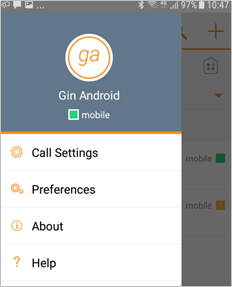
You can set your own presence by tapping on your personal status from the side navigation. It opens the My status screen where you can change your avatar, personal message, and presence status.
Your avatar is the picture that represents you in your friends’ Contacts lists and in chat screens. Tapping on an avatar opens a dialog with options to select an existing image, to take a new one with your device’s camera, or to clear your avatar.
You can enter a status message into the area next to the avatar. This status text is shown in your friends’ Contacts lists.
If you see the error message “Chat Unavailable” under any tab, it means that XMPP connectivity has been lost for chat and presence; however, you can still make calls. In this case, you should contact your service provider.
The client supports the following service management features, allowing supplementary services to be viewed or updated using the native client Preferences window:
Call Options
- Block My Caller ID
- Dialing Service
Call Forwarding
- No Answer
- Always
- Not Reachable
- Busy
Do Not Disturb
Incoming Calls
- Simulteneous Ring Personal
Office UC
- Call Director
- Remote Office
|
Option |
Description |
|
Call Options |
Block My caller ID - You can hide or display your number when calling or communicating with other parties or contacts. To hide your number, set to “Enable”. To show your number, set to “Disable”. Dialing Service - Choose between:
|
|
Call Forwarding |
By tapping on a different Call Forward option, you can enter a number to forward your calls to in the event of any of the following:
|
|
Do Not Disturb |
When you activate this service, all calls are blocked and sent to voicemail, where voicemail is available. |
|
Incoming Calls |
Simultaneous Ring Personal - This feature allows you to set up to ten phone numbers that would ring in addition to the primary phone number when you receive a call. |
|
Office UC |
Remote Office - This service allows the use of any phone as the office phone from a charging and numbering perspective. For instance, a hotel room phone can be used as the office phone. Enable Remote Office and specify a phone number to be used as the Remote Office number. Call Director - This service allows users to enable their mobile phones to behave as if the phones were an extension of their telephone number. Locations, numbers assigned to a mobile, can be added and the activated/deactivated at any time. Likewise when click-to-dial is enabled, the user can choose to notify all devices or just the primary device. Click on the Add Location button, enter the number of the phone that you wish to use, along with a brief description, followed by Active. The following options are then available:
|
The client supports the following preferences:
- Language
- Remember Password
- Troubleshooting
- Caller ID lookup
Language
You can change the language of the application from this option.
Remember Password
Allow the application to remember the password to make singing in easier.
Troubleshooting
The application requires a User to enter the correct Username and Password and have the correct features assigned. If the Username and/or Password are incorrect or the User does not have the required features then an appropriate error message will be displayed at the login process. If you are sure that the provisioning, login and licensing is correct then please check network connectivity, and the Requirements section of this document including Network and Firewall Requirements.
If problems still persist, logging can be enabled via the “Troubleshooting” menu within “Settings”. Once enabled, the application will collect information which can be emailed to your support engineers for further diagnostics. Troubleshooting is managed by a menu entry in Settings. It can be accessed from the following place:
- From the Settings/Preferences button – This opens the screen that contains the help and troubleshooting-related entries. This can also be used before the user has signed in.
Caller ID lookup
Whenever an incoming call does not have a calling name associated with it, the device performs a local contact search. If the number matches one of the contacts on the phone’s Contacts list, the name is shown on the incoming Call screen along with the alert.
Office UC provides support for users with multiple devices. This includes several features:
- Chat invitations are sent to all devices. Before the session is accepted, messages are sent to all devices, and once answered, the chat messages go to the device that has sent a reply message.
- Retrieving one’s own presence notifications, when another client updates the user’s presence. The client updates its own status based on the information it receives from the server.
- Accepting a shared presence invitation in one client is also recognized by another client, and both clients start receiving presence updates.
- A new presence subscription made in one client is recognized in another. If the contact blocks the invitation, there are presence notifications from the server to all of the user’s clients indicating that the subscription was terminated, and this information is shown to the user. If the client receives two presence authorization requests from two or more devices for the same user, it only shows one request to the user.
- Removing a contact from a Contacts list in one device is recognized in another client, and the Contacts list is updated (that is, the contact is removed) in the other client as well.

